Psychology
Chapter 5: Sensation
James Rowland Angell
Table of Contents | Next | Previous
Rudimentary Forms of Knowledge.-- We now take up in detail the several forms of cognitive process through which we attain knowledge. This undertaking will necessarily involve our examining various aspects of consciousness one at a time, and we must unavoidably turn our backs temporarily on most of the processes, apart from the special one we are --for the moment engaged in studying. We must bear constantly in mind, therefore, this partial and tentative mode .of procedure, remembering that the mind, which we thus analyse piecemeal, is in point of fact a real unit.
The first step in the activity of the sensory-motor circuit, which represents, as we have seen, the unit of action in the nervous system, is the sensory stimulation. This is reported in consciousness as a sensation, at which point we shall accordingly begin our detailed study of the various portions of our psychological processes. Some psychologists regard the feelings of pleasure and pain as even more primordial than sensation in this primitive sensory-motor activity of the organism. Be this as it may, we shall find it practically more convenient to examine the cognitive functions of the organism first; that is to say, those which inform us most definitely of an external world.
The Evolution of Sense Organs. -- That it may be put into the most delicate and complete accord with the world in which it is placed, the organism must be capable of responding to ,the various objects found therein. To this end we find the
(92) sense organs so devised that they may give information about the most widely differing kinds of physical existence.
There seems to be no doubt that even very simple forms of organism are sensitive in a rude way to most, if not all, of the types of sensory stimuli to which human beings respond, e. g., light, sound, mechanical impact, etc. This is simply another way of saying that protoplasm itself is sensitive to these modes of stimulation. But so far as concerns the development of definitely differentiated sense organs, specially devised to receive particular modes of sensory stimuli, the facts seem to indicate great irregularity and wide variation among different organic forms. The kinds of sensitivity which are most certainly and regularly present in the lower orders correspond most nearly to the human cutaneous sensations of touch, pain, and temperature. But beyond such a statement as this, we are hardly in a position to offer any definite outline of sensory development. Not a few' animal forms well up in the scale of organisms seem to possess sense organs unknown to man, the nature of whose functions we can, therefore, only speculate about. Moreover, when we come to animals on the level of the birds and quadrupeds, we come upon astonishing anomalies. For example, it seems probable that some birds are essentialy destitute of the sense of smell. This is said to be true of vultures. On the other band, dogs seem to live in a mental world in which smell probably plays a predominant part. Speaking generally, advance to any high level of intelligence is accompanied by an increasing prominence of vision and bearing, and a decreasing prominence for the rest of the sensations. This fact seems to be largely due to the superior richness and flexibility of the material supplied by these two senses for elaboration into ideational processes. Moreover, these senses are the ones which afford most detailed and accurate information of objects at a distance-an important consideration in developing organisms. Smell is their only rival in this particular, and for
(93) purposes of general orientation, as regards prey, or dangerous animal foes, is made large use of by wild creatures.
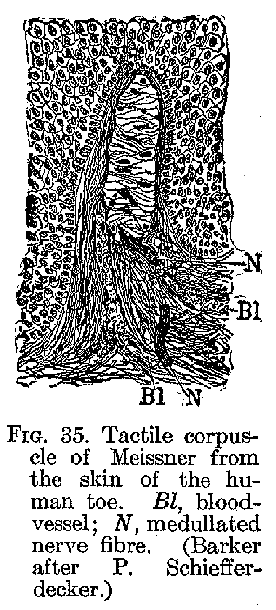 Neural Basis of Sensation in Man. (1) Cutaneous Sensations.[1] --
Each form of sensation which we possess is apparently connected with the activity of a
specially constituted end-organ. Thus, the sensations of touch or contact probably come
from the stimulation of minute structures in the dermis (figure 35), and from nerves
ending about the roots of the hair. It is fairly certain that children have a more
delicate and accurate sense of touch than adults. There is probably an anatomical reason
for this fact. The skin of the child contains practically the same nervous innervation as
does that of the adult, but the area thus innervated is much smaller. The difference is
most marked on surfaces which are not commonly used for touching. The touch, pain, and
temperature apparatus in the nervous system is fairly complete at birth. Sensations of
cold probably originate from organs in the skin, such as are shown in figure 36. It is
possible, though not wholly certain, that sensations of warmth come from special
structures, shown in figure 37; and in the epidermis are found the so-called free nerve
endings, i. e. nerve fibres which become much attenuated and terminate without contact
with any special end-organ. Their stimulation is believed to produce the cutting,
smarting, burning sensations of physical pain, which must not be confused with the
experience of mere disagreeableness, It will be seen, therefore, that the skin, which
affords a covering for all these structures, is in reality
Neural Basis of Sensation in Man. (1) Cutaneous Sensations.[1] --
Each form of sensation which we possess is apparently connected with the activity of a
specially constituted end-organ. Thus, the sensations of touch or contact probably come
from the stimulation of minute structures in the dermis (figure 35), and from nerves
ending about the roots of the hair. It is fairly certain that children have a more
delicate and accurate sense of touch than adults. There is probably an anatomical reason
for this fact. The skin of the child contains practically the same nervous innervation as
does that of the adult, but the area thus innervated is much smaller. The difference is
most marked on surfaces which are not commonly used for touching. The touch, pain, and
temperature apparatus in the nervous system is fairly complete at birth. Sensations of
cold probably originate from organs in the skin, such as are shown in figure 36. It is
possible, though not wholly certain, that sensations of warmth come from special
structures, shown in figure 37; and in the epidermis are found the so-called free nerve
endings, i. e. nerve fibres which become much attenuated and terminate without contact
with any special end-organ. Their stimulation is believed to produce the cutting,
smarting, burning sensations of physical pain, which must not be confused with the
experience of mere disagreeableness, It will be seen, therefore, that the skin, which
affords a covering for all these structures, is in reality
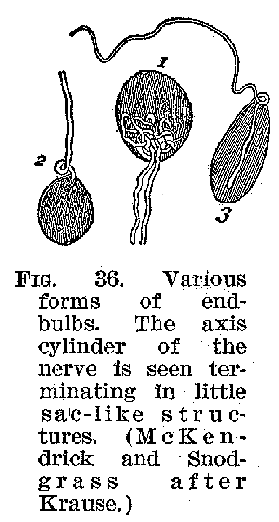 (94) a delicate mosaic of sensitive and insensitive spots. Certain spots will
respond to stimulations with a sensation of cold, as may be noticed by passing a pencil
point gently over the skin of the forearm; other spots with a sensation of pain, or
pressure, and others with a sensation of warmth. Moreover, these temperature sensations
can be produced by electrical stimulation, and by tapping upon the skin with an object
which is thermally indifferent. This fact would evidently seem to indicate the existence
of some special organ for these particular sensations. Naturally, the spots are very close
together, so that it is often possible to secure several kinds of sensations from what is
apparently one and the same spot. Figure 38 shows a rude map of these temperature spots,
which are less numerous than the pressure spots, and much less numerous than those
responding to pain sensations.
(94) a delicate mosaic of sensitive and insensitive spots. Certain spots will
respond to stimulations with a sensation of cold, as may be noticed by passing a pencil
point gently over the skin of the forearm; other spots with a sensation of pain, or
pressure, and others with a sensation of warmth. Moreover, these temperature sensations
can be produced by electrical stimulation, and by tapping upon the skin with an object
which is thermally indifferent. This fact would evidently seem to indicate the existence
of some special organ for these particular sensations. Naturally, the spots are very close
together, so that it is often possible to secure several kinds of sensations from what is
apparently one and the same spot. Figure 38 shows a rude map of these temperature spots,
which are less numerous than the pressure spots, and much less numerous than those
responding to pain sensations.
(2) Kinaesthetic Sensations.-- The insertions of the tendons and ligaments are supplied, as are the muscles, with sensory nerves, by means of which we are made aware of the rotation of the joints when we move any part of the body. The sensations produced in this way are called kinaesthetic. Of their condition at birth we cannot speak with confidence. They are evidently present, but how perfectly developed we do not know. We occasionally have sensations arising in the viscera, and these probably originate either in the pain nerves before mentioned or in nerves of the general tactile variety.
(3) Olfactory Sensations.-- The olfactory nerves terminate about the olfactory cells of the mucous membrane lining the upper portion of the nasal cavity. (Figures 39 and 40)
(95) The most acute perceptions of smell are probably not obtained before seven years of age, because of mechanical difficulties in the form of the nostril. The abundance of mucus
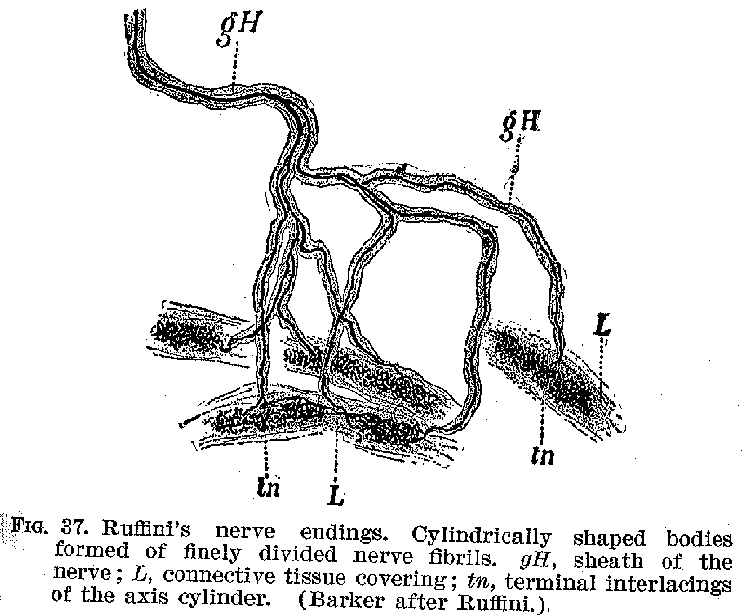
in infancy has a similar effect, producing obtuse smell sensitivities.
(4) Gustatory Sensations.-- The cells in the taste buds, found as a rule only on certain papillae of the tongue (though occasionally elsewhere in the mouth), furnish us with our taste sensations. (Figure 41.) This sense is well developed at birth, a fact which, perhaps, has a certain evolutionary significance. The sense is often defective in the feebleminded. It seems probable that there is still further differentiation of the forms of this end-organ; for certain regions, like the base of the tongue, are often especially sensitive to some one taste, in this case bitter. The sides of the tongue are particularly responsive to sour, the tip to sweet and to salt. The centre of the tongue is generally altogether insensitive to
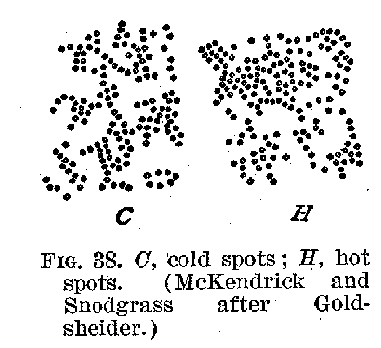 (96) taste. The leaves of the plant called gymnema sylvestre will,
if they be chewed, paralyse the sensitivity for bitter and sweet without affecting the
other tastes. Cocaine, if applied to the tongue, causes first a loss of the ability to
distinguish bitter, then sweet, and finally salt and sour. Furthermore, some substances,
e. g. saccharine, produce one taste in one part of the mouth, and another taste in another
part of the mouth. Saccharine is sweet to the tip, and bitter to the base, of the tongue.
All these facts are easy to explain, provided there are taste cells, which always respond,
however they are stimulated, with some one taste quality. But the facts are not all as yet
definitely determined, and we must consequently eschew dogmatic statements.
(96) taste. The leaves of the plant called gymnema sylvestre will,
if they be chewed, paralyse the sensitivity for bitter and sweet without affecting the
other tastes. Cocaine, if applied to the tongue, causes first a loss of the ability to
distinguish bitter, then sweet, and finally salt and sour. Furthermore, some substances,
e. g. saccharine, produce one taste in one part of the mouth, and another taste in another
part of the mouth. Saccharine is sweet to the tip, and bitter to the base, of the tongue.
All these facts are easy to explain, provided there are taste cells, which always respond,
however they are stimulated, with some one taste quality. But the facts are not all as yet
definitely determined, and we must consequently eschew dogmatic statements.
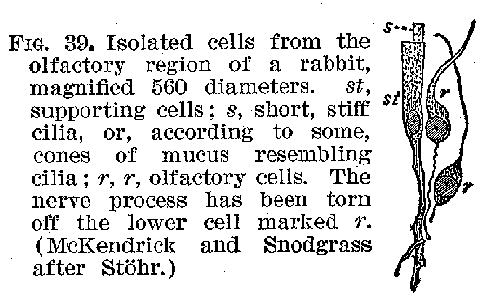 5) Auditory Sensations.-The auditory
nerves terminate at the base of hair cells in the internal ear, such as appear in figure
42. There are many thousands of these cells, and the precise mode of their stimulation by
vibrations of the air is extremely interesting, but too complex and too problematic for
detailed explanation here. Suffice it to say, that the hair cells are immersed in the
liquids contained by the sac-like membranes of the inner ear, and that the external ear
and the middle-ear contain physical devices (membranes joined by min-
5) Auditory Sensations.-The auditory
nerves terminate at the base of hair cells in the internal ear, such as appear in figure
42. There are many thousands of these cells, and the precise mode of their stimulation by
vibrations of the air is extremely interesting, but too complex and too problematic for
detailed explanation here. Suffice it to say, that the hair cells are immersed in the
liquids contained by the sac-like membranes of the inner ear, and that the external ear
and the middle-ear contain physical devices (membranes joined by min-
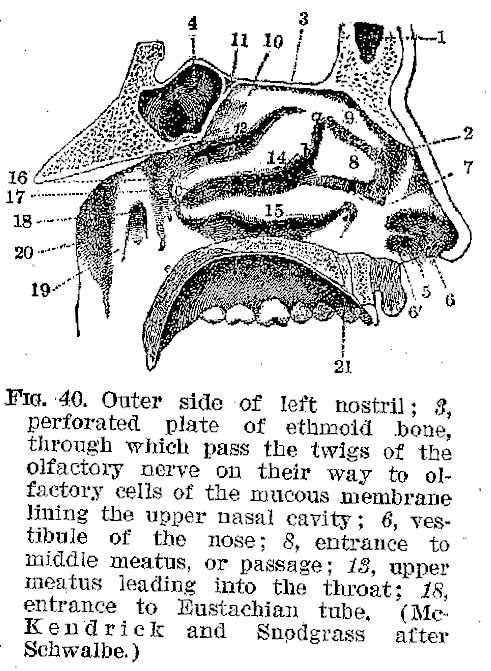 (97)-ute
bones) by means of' which the air waves outside the ear are gathered up and multiplied in
power, so that they may cause the liquids of the internal ear to vibrate, and thus
indirectly stimulate the hair cells. Figure 43 shows the essential parts of the ear. The
ear can respond with sensations of sound to vibrations of the air ranging from 16 per
second up to 50,000. The great majority of musical experiences arise from tones whose
vibration rates fall between 64 and 5,000 per second. We have once before called attention
to the fact that, owing to the presence of mucus in the middle and external ear, the
new-born child is generally insensitive to ordinary sounds. The position of the drum
membrane also contributes to this insensitivity. About four days after birth most children
will show response to loud sounds by expressions of fright. The sensitivity to
high-pitched seems to develop sooner than that to low sounds. Localisation of sounds seems
to begin with many children eat about four months of age. Children a year and more of age
often seems extremely sensitive to very weak sounds which older persons cannot hear at
all.
(97)-ute
bones) by means of' which the air waves outside the ear are gathered up and multiplied in
power, so that they may cause the liquids of the internal ear to vibrate, and thus
indirectly stimulate the hair cells. Figure 43 shows the essential parts of the ear. The
ear can respond with sensations of sound to vibrations of the air ranging from 16 per
second up to 50,000. The great majority of musical experiences arise from tones whose
vibration rates fall between 64 and 5,000 per second. We have once before called attention
to the fact that, owing to the presence of mucus in the middle and external ear, the
new-born child is generally insensitive to ordinary sounds. The position of the drum
membrane also contributes to this insensitivity. About four days after birth most children
will show response to loud sounds by expressions of fright. The sensitivity to
high-pitched seems to develop sooner than that to low sounds. Localisation of sounds seems
to begin with many children eat about four months of age. Children a year and more of age
often seems extremely sensitive to very weak sounds which older persons cannot hear at
all.
The semicircular canals of the internal ear (figure 44)
(98) also contain sensory nerves, which terminate, like the true auditory nerves, about the bases of hair cells. We are said to owe in part to these organs our sense of total bodily translocation, our awareness of our equilibrium, etc., matters to which we shall return in a later paragraph. The fluid in the canals contains little calcareous particles called otoliths. When the body moves in any given direction some of these otoliths are supposed to lag behind, because of their inertia, thus striking the hair cell filaments and setting up a sensory disturbance. As the canals are at right angles to one another, the fluids of some one or two of them would always be most affected by any single movement, and the sensations arising from them could thus by experience come to be connected with specific kinds of movements, e. g., forward, backward, upward, etc. We shall speak at a later point of the alleged sensations arising from these organs.
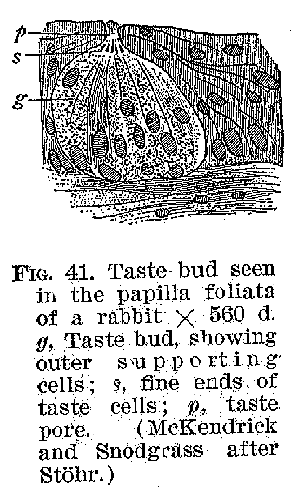 (6)
Visual Sensations. -- The retina, which differs from all the other sense organs
in being in reality a part of the brain removed by growth from its original location,
contains a most elaborate series of structures. These are shown in figure 45. As in the
case of the ear, we shall unfortunately be obliged to content ourselves with the most
cursory account of this interesting organ. The optic nerves enter from the back of each
eyeball, and the nerve fibres are then distributed radially all over the spherical
surfaces of the eyes, as far forward as the lens. (Figure 46.) The fibres turn backward,
away from. the centre of the eye, and lose themselves among the basal cells of the retinal
structure. The light waves make
(6)
Visual Sensations. -- The retina, which differs from all the other sense organs
in being in reality a part of the brain removed by growth from its original location,
contains a most elaborate series of structures. These are shown in figure 45. As in the
case of the ear, we shall unfortunately be obliged to content ourselves with the most
cursory account of this interesting organ. The optic nerves enter from the back of each
eyeball, and the nerve fibres are then distributed radially all over the spherical
surfaces of the eyes, as far forward as the lens. (Figure 46.) The fibres turn backward,
away from. the centre of the eye, and lose themselves among the basal cells of the retinal
structure. The light waves make
(99) their way in through the, dioptric media of the eye, i. e., the cornea, the aqueous humour, the lens, and the vitreous humour, and finally, after passing through the transparent optic fibres, come to the retinal end-organs, the rods and cones. (Figure 47.) At this point the physical ether vibrations which we call light set up physiological changes in the nerve, and the nervous current runs backward along the nerve fibres, and so to the brain.
The rods and cones respond to vibration rates of the ether between 440,000,000,000 and 4190,000,000,000 per second.
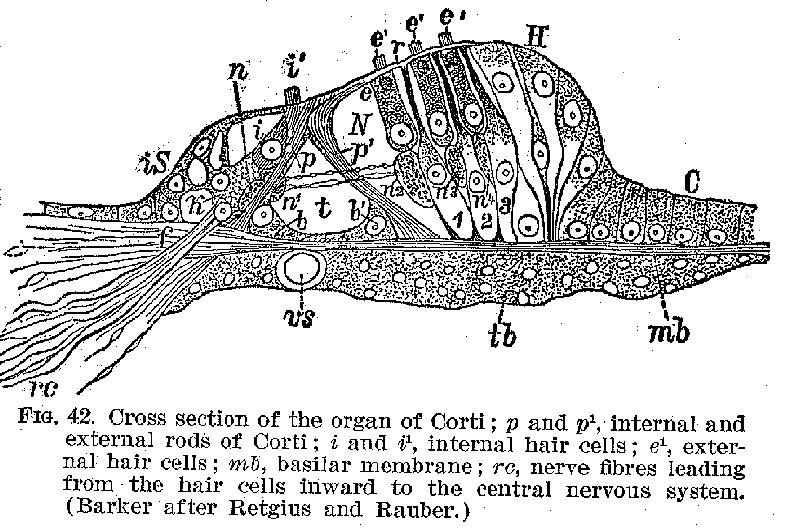
These are the rates of the light waves of the spectrum of the Sun. By means of the six muscles which are attached to the external surfaces of each eye we are enabled so to move the eyes as to bring the rays of light from the ob ject at which !'we are looking directly upon the central point of each retina, the so-called fovea centralis, the place of clearest vision. This process is convergence. By means of the lens in each eye, which can be made more or less convex, the rails of light from the object at which we are looking are brought to a
(100) focus upon this foveal spot, and thus we secure a clear, well-defined image upon each retina. This act is called accommodation.
The retina is fully developed at birth, and some children apparently have a slight control over the movements of fixa-
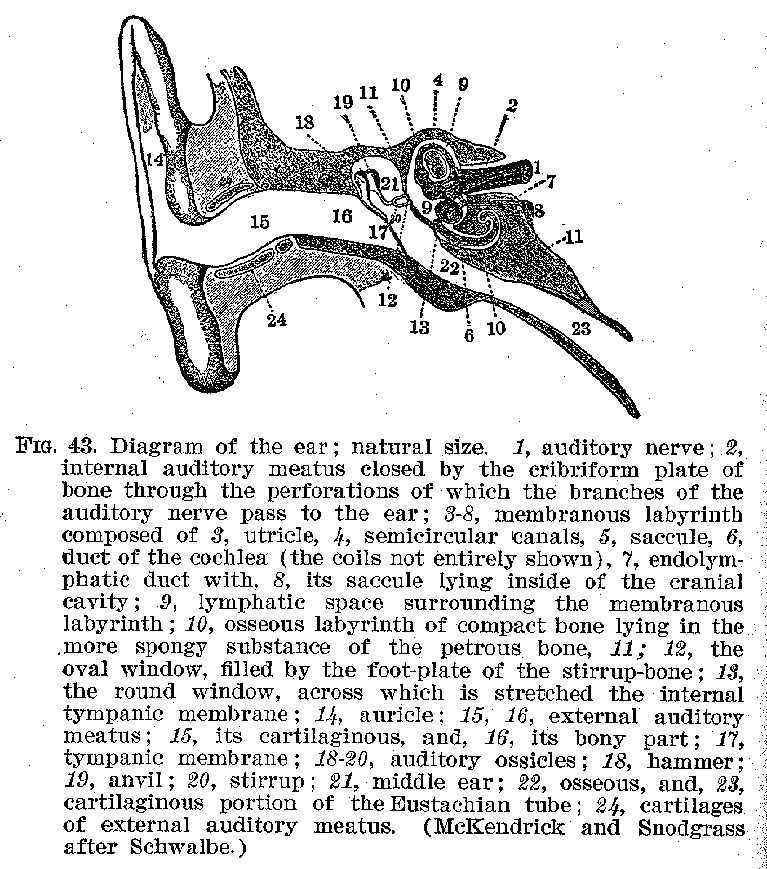
tion at birth. This is, however, rare, and such control generally does not come until the third week. But there is much variation. Older children surpass adults in their ability to see in a dim light, and to see small objects at a distance.
(101) This is probably because the optical media, e. g., the humours of the eye, etc., are with them more transparent. The colour sense is often apparently defective in children. But this probably means simply a lack of experience in distinguishing colours. The brighter colours are generally preferred. Genuine colour blindness is extremely rare among girls, whereas perhaps one in every twenty-five or thirty boys is defective.
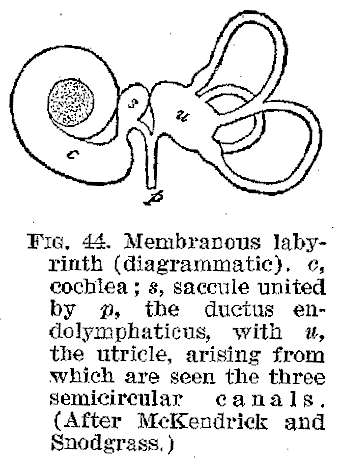 The
Elementary Qualities of Sensation. -- At this point the question naturally arises
as to the number and nature of the elementary sense qualities which the several sense
organs mediate. We must next address ourselves to the answering of this question, by
scrutinising each department of sensory activity. We may profitably remark, however, at
the outset of this undertaking, that these sensory qualities, such as redness and
blueness, warmth and cold, etc., with which we shall come into contact, are highly
abstract affairs, isolated by us for our psychological purposes from the larger matrix of actual
conscious experience of which they properly form part. Thus, for example, we are
never conscious merely and simply of the colour yellow. It is always a yellow object
of which we are aware, with some sort of contours, felt against a background of other
conscious processes, many of which are not even visual at all. But by turning our
analytical processes of attention upon the yellow part of the whole experience, we can
practically abstract it for our examination, and study it as though it actually occurred
singly and alone. Throughout the next few pages, therefore, we shall be engaged in this
process of abstracting pure sensory qualities
The
Elementary Qualities of Sensation. -- At this point the question naturally arises
as to the number and nature of the elementary sense qualities which the several sense
organs mediate. We must next address ourselves to the answering of this question, by
scrutinising each department of sensory activity. We may profitably remark, however, at
the outset of this undertaking, that these sensory qualities, such as redness and
blueness, warmth and cold, etc., with which we shall come into contact, are highly
abstract affairs, isolated by us for our psychological purposes from the larger matrix of actual
conscious experience of which they properly form part. Thus, for example, we are
never conscious merely and simply of the colour yellow. It is always a yellow object
of which we are aware, with some sort of contours, felt against a background of other
conscious processes, many of which are not even visual at all. But by turning our
analytical processes of attention upon the yellow part of the whole experience, we can
practically abstract it for our examination, and study it as though it actually occurred
singly and alone. Throughout the next few pages, therefore, we shall be engaged in this
process of abstracting pure sensory qualities
(102) for separate study. Indeed, in a certain sense, as we have already emphatically remarked, all our psychological analysis proceeds by abstracting now this and now that phase of con
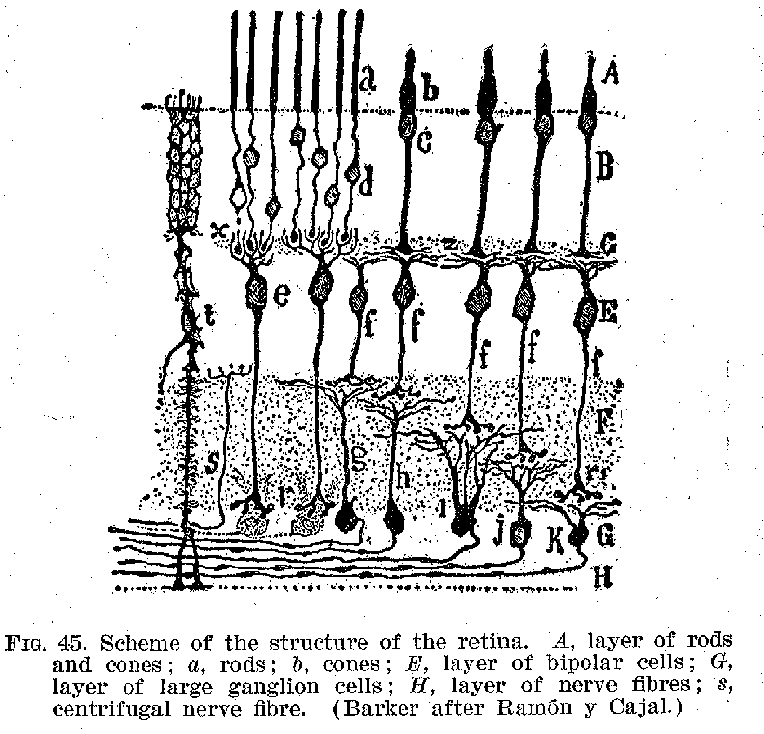
-sciousness for detailed inspection. But the fact requires especial notice in the case of sensations, which we are apt to think of as mentally independent and isolated facts. They are only independent and isolated in a thorough-going 'way, in so far as our reflective manipulation makes them so temporarily. We may add, by way of definition, that it is the consciousness of the qualities of objects stimulating the sense organs which most psychologists mean to designate by the term sensation.
Qualities of Dermal Sensation. -- From the skin we obtain
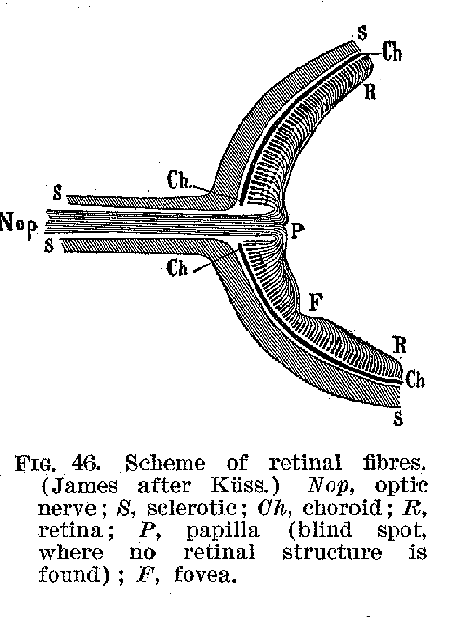 (103) as the rudimentary qualities of
sensation, cold, warmth, pain, land pressure; and some psychologists would add heat, a
sensation said to differ from warmth, and to be caused by the ,simultaneous stimulation of
cold and warmth. The evidence for this statement, as to the elementary qualities of the
cutaneous sensations, consists in the careful examination of every kind of psychical
experience which we can obtain from the stimulation of the skin. At first, it may seem
that we have many other elementary qualities peculiar to cutaneous reactions. Thus, it is
common in the older text-books to see such asserted sensations as hardness, softness,
wetness, dryness, active and passive touch, sharpness, smoothness, roughness, etc.,
referred to the skin. It is true, of course, that these several impressions originate in
the skin. But they are quite certainly either compounds of pressure with some of the
!other sensations already mentioned, or else mere modifications of pressure itself. Thus,
if one heat a drop of water to the exact temperature of skin and then place it on the
hand, it will very difficult to imagine any sensation caused by it other than pressure.
Similarly, if a hard and a soft object be made thermally indifferent, and both be laid
very gently against the skin, pressure will be the only sensation confidently felt. As the
intensity of the pressure increases, the ",difference will be remarked. But hardness
simply means
(103) as the rudimentary qualities of
sensation, cold, warmth, pain, land pressure; and some psychologists would add heat, a
sensation said to differ from warmth, and to be caused by the ,simultaneous stimulation of
cold and warmth. The evidence for this statement, as to the elementary qualities of the
cutaneous sensations, consists in the careful examination of every kind of psychical
experience which we can obtain from the stimulation of the skin. At first, it may seem
that we have many other elementary qualities peculiar to cutaneous reactions. Thus, it is
common in the older text-books to see such asserted sensations as hardness, softness,
wetness, dryness, active and passive touch, sharpness, smoothness, roughness, etc.,
referred to the skin. It is true, of course, that these several impressions originate in
the skin. But they are quite certainly either compounds of pressure with some of the
!other sensations already mentioned, or else mere modifications of pressure itself. Thus,
if one heat a drop of water to the exact temperature of skin and then place it on the
hand, it will very difficult to imagine any sensation caused by it other than pressure.
Similarly, if a hard and a soft object be made thermally indifferent, and both be laid
very gently against the skin, pressure will be the only sensation confidently felt. As the
intensity of the pressure increases, the ",difference will be remarked. But hardness
simply means
(104) more intense pressure, plus, on most occasions, certain sensations of effort, resistance, or strain, which comes from muscles or tendons, and not from the skin. And so with the other experiences suggested above. When carefully examined, they will all be found capable of resolution into pressure, or pressure and some other sensation, like that of temperature, or tendinous strain. Itching, tickling, and creepy sensations of the skin probably originate at times from the effects upon the dermal end-organs of circulatory changes. Occasionally, however, they are due to very light pressure stimulations. The
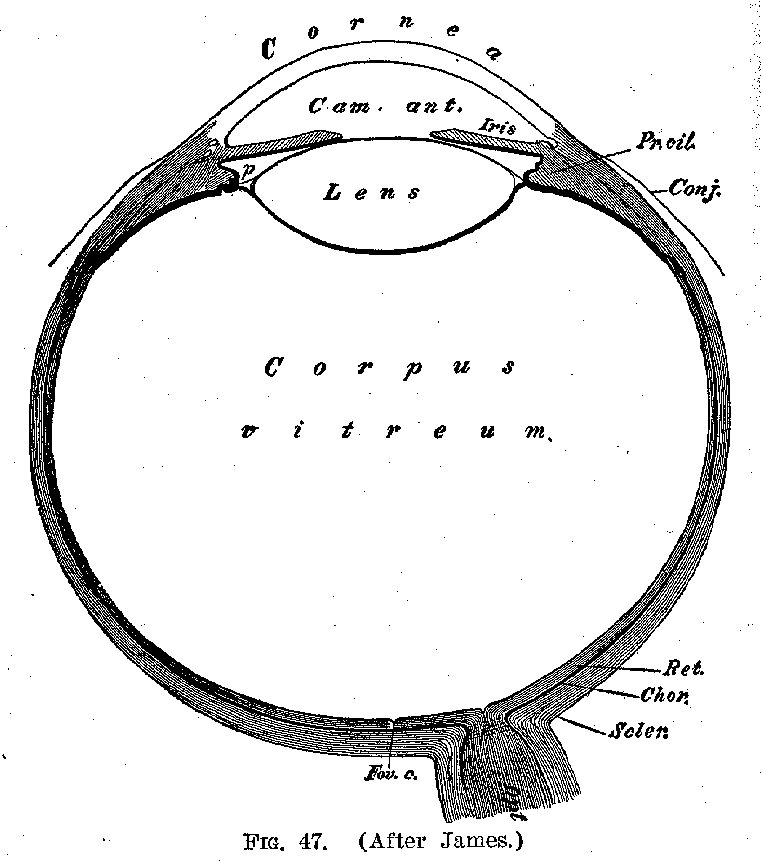
(105) creepy feeling is often a coin lex of the prickly pain sensations with cold sensations, etc. There seems no reason to postulate any new elementary forms of sense experience because of these reactions.
Kinaesthetic Sensation Qualities. -- Closely connected with the skin sensations are the kinaesthetic, or organic, sensations. When one lifts a heavy weight there is, quickly noticeable, over and above the pressure sensation in the hand, a feeling of strain in the arm. When the hand is firmly clasped this strain is also detectable. This sensation without doubt is largely referable to the sensory nerves about the tendons. The muscles, also, have sensory nerves, as we have noted in a previous paragraph, and there is undoubtedly a muscle sensation. But it is hardly possible introspectively to isolate the sensation without experimental appliances, except in the case of moderate muscular fatigue. The feeling which arises under such conditions of fatigue is, then, the specific sensation concerned. The joints, also, are probably indirect contributors to this group of sensations, through their effect upon the tendons. Certainly we are extremely sensitive to their movements. The sensation which is experienced when we attempt to isolate the joint activity is strikingly like ordinary pressure. This isolation can be accomplished with sufficient accuracy, by attaching a heavy weight to a cord, and then, while holding the cord, allowing the weight to sink rapidly to the ground. At the moment when it strikes, one feels a sort of " snap-back " sensation in the joints.
Sensations From the Semicircular Canals. -- Many authors are inclined to ascribe a pair of specific sensations intimately connected with the above (provided they are genuine sensations) to the semicircular canals of the internal ear. These canals, upon the basis of this view, are supposed to produce the sensation of dizziness, and the sensation of change of rate of movement, when the whole body is being moved, as occurs when one is on a railroad train. It should be said of
(106) these dizziness sensations, that the eyes play a very large part in them, and also that various muscles may be engaged in their production. There is, thus, in no case any conscious reference by us of the sensations to the semicircular canal region. We simply feel our balance disturbed, and note the misbehaviour of the visual field.
Organic Sensations.-- The respiratory and circulatory proc. esses produce certain sensory experiences closely akin to the cutaneous ones, e. g., the sensation of " closeness " in the air, perhaps, comes from a genuine intra-thoracic sensation. The sexual organs have a specific sensory quality, and the alimentary tract gives rise to the experiences of nausea, thirst, and hunger. It may, perhaps, be questioned whether these last experiences are not resolvable into other simpler constituent sensation qualities, in which pressure and pain, for example, possibly play a part, and with which the affective factors of pleasantness and unpleasantness are markedly connected. But the disposition among psychologists seems on the whole to be in favour of regarding them as real sensations, with probably some specific end-organ, although the case is far from clear.
Olfactory Qualities. -- It is impossible at the present time to say anything definite about the elementary sense qualities of smell. The evidence at present available would make it seem probable that the number is large. We seldom make any attempt at classifying odours by their sense qualities, probably because practical exigencies do not require it. Our only common classification is based upon the affective consequences of the odour stimuli, which we divide into the two great classes, agreeable and disagreeable. We designate odours by the objects from which they come, e. g., violet, orange, leather, etc., adding occasionally to these terms metaphors borrowed from taste, e. g., sour, sweet, terms which are not always applied -unambiguously to the mere sense quality, but often involve reference to affective processes, and to other
(107) concomitant activities, both muscular and sensory. For example a sour smell is often one which stirs up unpleasant gustatory sensations, with choking contractions of the throat. The classification most used in a practical way at the present time is Zwaardemaker's modification of Linnaeus' table:
1-Ethereal smells, including fruit odours.
2-Aromatic smells e. g., camphor, spice.
3-Fragrant smells e. g., many flowers, violets, sweet peas, etc.
4-Ambrosiac smells, e. g., musk.
5-Alliaceous smells e. g. garlic, chlorine.
6-Empyreumatic smells, e. g., burning tobacco, burnt toast, coffee.
7-Hircine sniells, e. g., cheese.
8-Virulent sinells, c. g., opium.
9-Nauseous smells e. q., decaying animal matter.
This classification of the table has a purely practical value, however, and cannot be in any way accepted as representing the irreducible sense qualities.
The Qualities of Taste Sensations. -- There are, without much question, four and only four elementary qualities of taste sensation, i. e., sour, salt, sweet, and bitter. What we commonly call tastes are generally compounds, or fusions, of taste with temperature, pressure, and smell. Thus, as we have remarked at an earlier point, the characteristic taste of onions will be found astonishingly altered, if one close the nostrils firmly before taking the onion into the mouth. Some authorities incline to add two other elementary tastes to the list of gustatory- qualities, i. e., alkaline and metallic. But on the whole, it seems probable that these are compounds of the others already mentioned. Certainly it is remarkable to see how completely these four suffice to describe the true taste sensations, when we are given a large number of substances to test by taste alone, without knowing in advance what they are to be. To make this experiment satisfactorily, one must
(108) see to it that smell is absolutely ruled out, that the temperature of the substances is that of the mouth itself; and one must be careful not to confuse the pricking, puckering effects of certain substances, which are not taste sensations at all, with the true taste quality. Furthermore, one must employ solutions to make the test, for many food substances prod-Lice characteristic contact sensations which we instantly recognise. Finally, there is a striking difference in the sensitiveness of various parts of the tongue, as was pointed out in an earlier paragraph, to these four kinds of taste stimuli. No other tastes show this local peculiarity.
Auditory Qualities.-- Our auditory sensations fall naturally into two great groups-- noises and tones. But each of these can be subdivided again into a very large number of distinguishable qualities. We get the sensation qualities which we call noise when less than two complete vibrations of a sound wave are allowed to reach the ear; or, what is perhaps, owing to the reflection of the so-Lind, the same thing, when tile waves which do reach the ear. are irregular and non-periodic in their mode of vibration. These irregularities may evidently be indefinite in number, and so we get such differences in the sounds as distinguish, for example, the noise of a train from the noise of a drum. These last mentioned cases, however, are what are called complex noises, and are conceived as made up of aggregations of the simple noises first mentioned, of which we can detect some 550 or more. The sensation of tone comes from bodies which vibrate periodically and regularly, like the pendulum. Such bodies are represented best by tuning-forks. In this case we can distinguish some 11,000 qualities. The differences among these qualities are primarily what we call differences in pitch. These arise from differences in the vibration rates of the sounds, and, as we have already learned, we can hear tones ranging in vibration rate from 16 to 50,000 per second. It must be remembered that the musical tones which we commonly hear are not sim-
(109) -ple, but complex, being constituted of a number of tones -the fundamental and its overtones. The nature, num- ber, and relative intensity of these partial tones determines the timbre of a sound. The characteristic differences in the tone quality of different instruments has this fact as its basis. In the piano, for instance, there is a rich and well-balanced set of the lower partial tones. In the clarinet the odd overtones are predominant; in the flute these overtones are few and weak, etc. The evidence for these facts is not easily obtained without the use of apparatus. But the rough acoustic difference between noise and tone is fortunately familiar to us all, and the other points which we have noted we shall have to accept on authority.
Visual Qualities.-- Like the auditory sensations, our visual sensations fall into two general classes -- sensations of brightness and sensations of colour. The brightness sensations are caused by the impingement upon the retina of mixed light waves of various lengths; thus, what we call white light is made up of light waves of all lengths. Pure colour sensations, are produced by homogeneous light waves,, or waves of practically equal length. As a matter of fact, we. never experience colours without getting a measure of brightness sensation also. Although it is convenient to distinguish the two forms of sensation from one another, this concomitance must not be forgotten. If we gradually decrease the intensity of white light, we pass first through a series of shades, to which we should ordinarily apply the name grey, and come finally to black. Black and white are thus tile extremes of the brightness series of sensations, and between them occur the various shades of grey. We are able to distinguish some 700 different brightness qualities between the deepest black and the most brilliant white.
We are in the habit of referring to the spectral colours, or qualities, as being seven in number, i. e., red, orange, yellow, green, blue, indigo-blue, and violet. This is, however, a
(110) merely practical and somewhat arbitrary division. These Dames apply to distinctions in colour tone which we promptly and easily remark when looking at a sunlight spectrum. But in reality the colour between pure green and pure blue is just as truly entitled to a separate name as is orange, a colour which distinctly suggests both red and yellow. Purple, too, which can be formed by mixing red and violet, the colours at the ends of the spectrum, is a perfectly genuine colour quality, deserving to rank in this respect with the spectrum colours themselves. When we are given proper experimental conditions we find we can distinguish some 150 spectral qualities. This includes the purple.
Elementary Colour Relations. (1) Mixtures and Complementaries. -- If we now apply to vision the mode of analysis we have employed heretofore in the case of other sensations, and attempt to reduce the visual spectral qualities, apart from brightness, to those which seem really elementary, we shall find four such colours remaining, i. e., red, yellow, green, and blue. All the others, when closely inspected, appear to us to be compounds. Orange, we have already remarked, appears both reddish and yellowish. Violet has traces both of blue and red, and so with all the transitional hues leading from one of these elementary colours to another. Moreover, if we be given these four colours, we can, as we should naturally expect, produce all the other spectral hues by mixing these elements in proper proportions. Among the mixtures which we can make in this way are certain very peculiar ones, which result when we take two such colours as yellow and blue, or red and blue-green. These pairs of colours ours, when mixed together, give us, instead of a new spectral hue, simply grey. Colours whose mixture results thus in grey are called complementary colours, and every colour has some complementary in the spectral series, except green, whose complementary is purple, a mixture of red and blue. (Figure 48 shows these relations.)
(111)
(2) After-Images.-- Our visual sensations are in one particular very remarkable, as compared with our sensations of other kinds. The after-effects of sensory stimulation last longer and are more peculiar than is apparently the case else
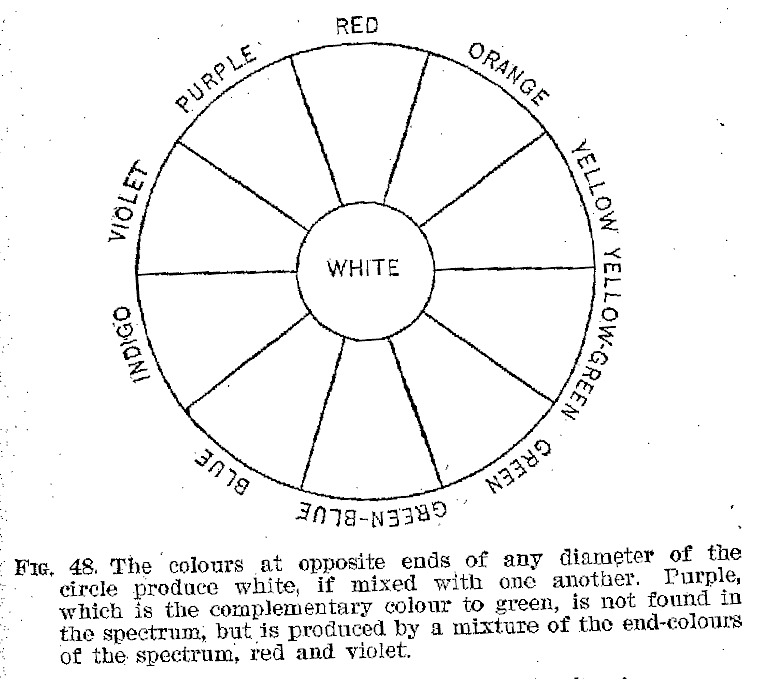
where. There are two principal forms of after-images, as they are called, i. e., positive and negative. After-sensations would, perhaps, be the better term for them. If one suddenly looks at a very bright light, and then closes the eyes, the light continues to be seen for some seconds in its proper intensity and hue. This phenomenon is a positive after-image. if one looks for a few seconds fixedly at a bit of blue paper, and then closes the eyes, or turns them upon some neutral grey back-ground, one sees a yellow patch corresponding in shape to the blue stimulus. This is a negative image. Negative. images invert the relations of brightness in the stimulus, so
(112) that what was white in the object appears black in the afterimage, and vice versa. They also convert all spectral colours and their compounds into their several complementaries. While all the senses display after-effects similar to the positive visual after-image, none of them has anything precisely comparable with the negative image.
(3) Colour Contrast.-- The phenomena of contrast also, although characterising in a measure all sense domains, and for that matter all conscious processes, are especially striking in vision. Yellow and blue appear respectively yellower and bluer, when seen side by side, than when seen apart, This seems to be largely because of the fact that the eye moves slightly from one to the other; and the eye fatigued for blue already has a disposition to react with the yellow after-image. If the part of the retina containing this yellow after-image process is then exposed to the real objective yellow, the power of the stimulus is much enhanced, and we see a deeper, more intense yellow than we otherwise should. This phenomenon is called successive contrast. Simultaneous contrast is an even more interesting phenomenon, and may be illustrated by putting a small bit of grey paper upon any coloured field, and then covering the whole with thin white tissue paper. The grey patch will, under such conditions, always appear as of a colour complementary to that of the field, i. e., it will appear blue, when the field is yellow; yellow, when it is blue; reddish when it is green, etc. The explanations offered for this phenomenon would take us too far into physiological psychology and we must rest content with the general conclusion that our colour sensations are dependent, not only upon the colour of the objects immediately fixated, but also upon the colours surrounding it, and upon the immediately preceding stimulation.
(4) Defects in Colour Vision.-- Finally, we may remark, that the peripheral portions of the retina are seriously defective in their colour reactions. Accurate colour vision
(113) belongs only to the central portion of the retina around the fovea. According to most observers, red and green are only seen accurately for a short distance outside this region. Yellow and blue are lost next, and in the extreme periphery only white and grey can be sensed. This condition suggests pathological colour-blindness from which many persons suffer even at the fovea.
Compound Qualities.-- In addition to these colour sensations of which we have been speaking, large numbers exist formed by combining the several spectral qualities (150) with the brightness qualities (700). Some 30,000 distinguishable qualities can be produced in this way. Thus red, for example, can be mixed with white to produce various tints, which we call pink; or with black to produce various shades, which we designate brown. Figure 49 displays in a general wail these relations.
Summary of Sensation Qualities.-- Reverting now in conclusion to the matter from which we started, and taking all these sensations into account, which we have found originating in the various sense organs, we shall find that, even disregarding smell, of which we cannot speak confidently, we are supplied with more than 42,000 distinguishable sensory qualities. On the other hand, if we consider only the irreducible sense qualities, like redness and sweetness, and call these the sensation elements, we have probably not more than 20 or 25 when smell and sound are left out of the count. The problem of reduction to simple sense forms is, in the case of these last two groups of sensations, fraught with great difficulty and uncertainty.
The Intensity of Sensations.-- We have remarked incidentally a number of times in this chapter, that our sensations originate from the stimulation of a specific sense-organ by some form of motion in the physical world about us, such, for example, as the air waves, the ether waves, the heat waves, etc. But it is not only necessary that these various forms of
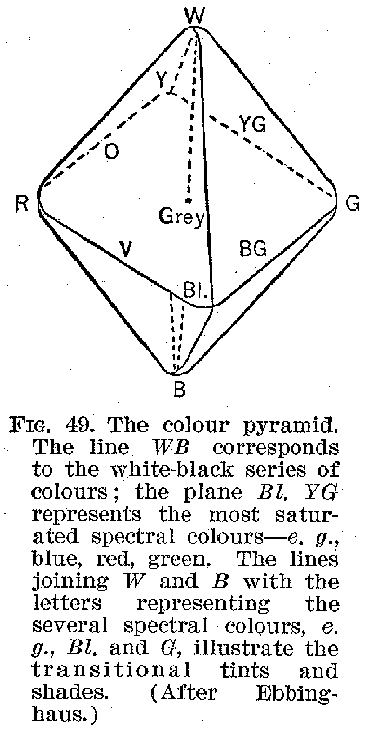 (114)
stimuli should fall upon the sense or gans. It is also necessary that they should possess
sufficient intensity, if we are to become conscious of them. A very faint light, a very
faint sound, a very faint odour, may fail altogether to produce a sensation in us. The
point at which such a stimulus becomes intense enough to produce a sensation is called the
limen, or the threshold. It is also a matter of frequent observation that when sensory
stimuli become very intense they cease to be felt as they were before, and we experience
pain instead. A very bright and blinding light may cause acute pain. A loud, shrill sound,
extreme heat, and extreme cold are all painful. The point at which the various stimuli are
thus felt as painful is known as the upper limit of sensation. Between the limen
and the upper limit fall an indefinite number of gradations of sensory intensities. It
should be noted in passing, that certain olfactory and gustatory stimuli can hardly be
obtained in sufficient intensity to be called painful; and also that many very weak
sensations are unpleasant, e. g. weak sounds and faint lights, the tickling from delicate
contact, etc.
(114)
stimuli should fall upon the sense or gans. It is also necessary that they should possess
sufficient intensity, if we are to become conscious of them. A very faint light, a very
faint sound, a very faint odour, may fail altogether to produce a sensation in us. The
point at which such a stimulus becomes intense enough to produce a sensation is called the
limen, or the threshold. It is also a matter of frequent observation that when sensory
stimuli become very intense they cease to be felt as they were before, and we experience
pain instead. A very bright and blinding light may cause acute pain. A loud, shrill sound,
extreme heat, and extreme cold are all painful. The point at which the various stimuli are
thus felt as painful is known as the upper limit of sensation. Between the limen
and the upper limit fall an indefinite number of gradations of sensory intensities. It
should be noted in passing, that certain olfactory and gustatory stimuli can hardly be
obtained in sufficient intensity to be called painful; and also that many very weak
sensations are unpleasant, e. g. weak sounds and faint lights, the tickling from delicate
contact, etc.
Weber's Law. -- Exhaustive experiments have revealed a very interesting law, known after its first careful investigator as " Weber's Law," which obtains among the relations of these sensation intensities, as we experience them. When we
(115) place a weight of 20 grains upon the hand, we find that we observe no change in the pressure sensation until a whole gram has been added to the 20. If we take 100 grams we must add 5 grams before we can observe the change in intensity; and, speaking generally, whatever absolute weight we start with, we find always that we must add the same fraction of its own weight, that is, 1-20, in order to feel that the weight pressure has changed. A similar thing holds true of the intensity of sounds, but in this case the fraction is approximatelv 1-3. In sensations of brightness the change must be 1-100, etc. In all these cases the formula is most nearly true in the medium ranges of intensity. When we approach the limen or the upper limit, the relations seem to become irregular, and in the case of certain senses, like smell, the application of the law is somewhat dubious.
Duration of Sensations.-- We have seen that every stimulus must possess a definite intensity before it can give rise to a
sensation; and it is even more obvious that every such stimulus must also possess a certain duration, if it is to be felt. More over, many sensations are very profoundly altered by prolonged duration. Thus, colour sensations will be found to grow dim and to fade, if long continued. Some sensations of sound, on the other hand, seem to become more intense, if continued, and finally occasion pain. The detailed facts about the influence of duration upon sensory processes cannot present be both accurately and briefly set forth, and we shall therefore pass them by.
Extensity in Sensations.-- Certain sensations, like those of vision and touch, always possess, in addition to the previously mentioned characteristics of duration and intensity, a definite spatial quality. Some distinguished psychological authorities insist that all sensations are thus spatial, sensation sound and smell and taste, as well as those of touch and sight. This is not, however, the prevalent view, and we all not discuss the matter here. Suffice it to say, that a
(116) colour sensation cannot exist at all without being experienced as possessing extensity. The same thing is true of pressure; and, in general, all sensations which ever possess the quality of extensity always possess it, just as they possess duration and intensity. The kinaesthetic sensations are admitted by all psychologists to belong, with pressure, temperature, and vision, to the spatial senses.
If we bring together the points we have gone over in discussing the quality, extensity, duration, and intensity of sensations, we shall see that quality is, in a definite sense, the most fundamental thing about a sensation, and that the other characteristics can fairly be regarded, for our psychological purposes, as subordinate attributes of quality. Thus, a given musical tone may last one second, or three, without essential. change of the pitch, which is its quality, psychologically, speaking. It may be louder, or softer, without changing its pitch. Furthermore, it may change its timbre, which seems to be a sort of secondary quality, by changing its overtones, and still retain its pitch, or primary quality, unaltered. Similarly, a sensation of red may come from an object one inch square, or from one two inches square, without noticeably changing the hue of the colour.
General Characteristic of the Sensation Quality. -- The fundamental characteristic common to all the sensations is a certain something which they occasion in us, for which shock is possibly the most appropriate name. This characterises all transition in consciousness, and especially consciousness of immediate sense activities.
Primary Function of Sensation. -- A consideration of the sensory-motor circuit makes it evident that the primary organic function of the sensory element in consciousness must be that of instigating movements. Moreover, in Chapter 111. we examined certain typical instances, in which we found sensation processes operating to produce movements, and then further operating to report the results of those movements,
(117) thus assisting in the establishment of useful coordinations. Although we shall be analysing in the next few chapters the details in the process of acquiring control over the movements which sensations thus bring about, it only remains, so far as concerns the rudiments of this process, to add one thing. When we say that sensory stimulation ensnares movements, we must not make too sharp a distinction between the stimulation, as sensed, and the movement, when a response is made without deliberation. The nervous process is practically a continuous forward movement of impulses from the sense organs clear around to the muscles. There is nowhere any essential break in this feature of the activity. The act is literally a unit.
Similarly, if we examine the facts closely, we shall see that the sensory reaction is simply the registration in consciousness of a certain kind of act, and that it varies markedly with the kind of response that is executed by the muscles. What we should commonly call a sensation of a disagreeable odour consists not only in the consciousness of a certain kind of olfactory quality; it consists also in the consciousness of tendencies to movement, e. g., choking movements in the throat, violent expiratory movements, movements of the head away from the source of the odour, etc. The sensation of the odour is instantly merged with other sensations which these movements call out, and is markedly modified by them. Furthermore, the kind of sensation which we get from an odour in the first instance will be definitely determined by the kind of movement in progress at the moment when we come into contact with the stimulus. If we are not expecting the odour, our breathing may be free and deep. In consequence, we obtain a deep inhalation of the noxious fumes, and from the blending of this impression with the ongoing mental activity, one kind of sensation results. If we are expecting the odour, or if our breathing happens momentarily to be superficial, the sensation is much modified and weakened. So we
(118) see that our consciousness of sensory stimuli is qualified on both sides by movements, i. e., by those movements which lead up to it, and by those which follow it. The sensation-movement process is, therefore, essentially a continuous thing, and our analysis of it into parts is simply for the readier apprehension of its characteristics, and does not at all imply any such actual severance of the various stages of it.
Secondary Function of Sensation.-- When our attention is called to the fact, we readily notice, as was intimated earlier in the chapter, that if our sense organs are stimulated, we are commonly made conscious of objects, rather than of mere qualities, such as we have been describing in this chapter. Thus, if our eyes are exposed to stimulations of light, we ordinarily see such things as people, or trees, or houses, and we do not think of such objects as being merely so much colour. We can, of course, note and recall the colours which belong to these objects, but as our eyes test upon them we are certainly in adult life infrequently conscious of them as mere aggregates of colour qualities. Similarly, when we hear familiar words, it is very rare that the simple quality of the vocal sounds monopolises our attention. Instead of this, we are instantly absorbed in the meaning of the words. On the other hand, a single musical tone, an unfamiliar fragrance, a feeling of warmth, may enter our consciousness almost as pure qualities, to the objective character of which we are practically oblivious. Now, the difference between these two classes of experience marks the difference between sensation and the next of the cognitive processes which we shall study, i. e., perception; and before we can understand satisfactorily the function of sensation, we must attempt to make the distinction clear.
Sensation and Perception.-- In the previous chapter we remarked upon the manner in which attention succeeds by dissociation in breaking up the conscious continuum of infancy into distinguishable portions. The infant conscious-
(119)-ness, so far as concerns its cognitive features, must be at the outset almost wholly a consciousness of the vague sensation kind, a consciousness of undifferentiated fusions of sensory qualities, plus pleasantness and unpleasantness, which are here temporarily disregarded. Little by little, through the discriminative and associative activities of attention, these qualities become disintegrated and attached to certain recurrent experiences. A visual quality becomes in this fashion extradited, and connected with a kinaesthetic quality from the movement of the hand and arm. Presently in this process the visual consciousness loses its former disconnected vagueness, and becomes an explicitly recognised sign, or symbol, of the hand movement, and, perhaps, of the further agreeable experiences connected with the allaying of hunger. In this way comes to pass the baby's consciousness of his bottle, as an object external to himself. The process is evidently one which involves the extrusion, from a vague mass of sensory consciousness, of the several fusions of sensations concerned; and then, the further process of relating these sensory groups to one another. Now, so far as we ever approximate the obtaining of a sense quality, severed in all respects, save that of time, from the rest of our consciousness, so far do we tend to become aware merely of quality; but the moment the relating activity becomes vitally operative, at that moment do we tend to lose the experience as a mere quality, and begin to give it objective character. Speaking in an absolutely literal way, this relating activity is of course never wholly absent; and consequently, save for the hypothetical first moment of consciousness, we are -never able to get a really pure sensation. Sensation is in this sense, therefore, an abstraction, as we have already insisted. But, speaking relatively, such illustrations as those from which we started bring out the very striking differences in the degree to which we retain the primary ability to cognise mere quality, as distinguished from the tendency to react upon the sensory stimulations as objects.
(120)
James has hit off the point, in one of his happy inspirations, in saying that sensation gives us mere acquaintance with objects," whereas perception gives us "knowledge about" them. As a matter of fact, it is clear that our sensory experiences which involve simply becoming acquainted with objects are few and far between. The all but universal reaction is one in which we place, or classify, or recognise, the stimulus in some way , thus relating it vitally to our past knowledge. It should be added, too, that this assignment of objective character to our sense experiences is especially prompt and convincing in those senses which most definitely contribute to our awareness of extension, resistance, and externality to the organism, i. e., touch and vision.
Limitations of Sensation.-- In general, we may say that the function of sensation is to furnish -us with the elementary symbols of the various things in the world about us which stimulate our sensory-motor activities, e. g., odours, colours, sounds, etc. Moreover, it must not be for-often that, despite the elaborations which it undergoes, this sensuous raw material continues throughout our lives to furnish the body the content, of all our sensory consciousness; and as our minds pass from one sense element to another, the fact is. as we have already observed, reported by a sort of delicate shock, which is therefore a factor common to all sensation processes. So far as a mere simple symbol is all we need, so far we tend to rest content with the fie mere awareness of the sensory quality;' but there are many kinds of things with which we must come into daily contact for which such symbols are inadequate, because they do not reflect with sufficient accuracy and detail the complexity of the object or stimulus. Consciousness of odours occasionally approximates the condition of sensation) by rendering us aware of specific qualities which relate themselves only in the vaguest way to our past experience, and which we do not think of as objects. Such stimuli are for' us essentially simple. But our visual consciousness of the
(121) external world is always more or less complex; it always involves more or less of different colours, each of which has its own qualities; and we must consequently become aware of a group of these sensory qualities experienced simultaneously. Such fusions of sensation elements, with their wealth of suggested reactions and relations, we think of as objects.
Similarly, if a very small point be brought in contact with the skin we feel what we call a sensation of touch; and such a sensation, if very light, may fail to suggest definitely any object whatsoever. But if a large area is stimulated by contact. we instantly recognise such a complex of sensory qualities as being an object, whose nature we generally appreciate with some accuracy. The consciousness of relatively isolated simple qualities is, accordingly, when produced by stimulating the sense organ, what we mean by primary, or peripherally aroused, sensation. When the qualities cease to be simple, and take on definite relations to one another, and to us, especially that of externality, we have the consciousness of objects, -which is commonly called perception. Clearly, then, sensation as the consciousness of isolated qualities is a product of mature abstraction. Sensation, as giving the qualitative determinant to all sensory experience, is not only the first stage in the perceptual process, furnishing the vague undifferentiated matrix out of which the richness of qualitative variety is later extradited by analysis, but it is also the constant accompaniment of sensory activities, giving the stuff, the material, out of which perception is elaborated. To a fuller account of the perceptual stage in the cognitive function we must next proceed.